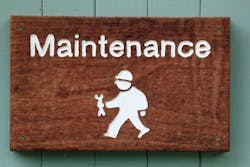Taking Responsibility for Maintenance Mishaps
Sometimes things don’t go right in a factory. A crucial shipment misses its shipping deadline, scrap rates soar, or a critical production machine goes belly up. Department managers worry about not just losing a promotion but also losing their job. And then the finger pointing begins. A contest of who can spin the most plausible denials ensues. Feelings get hurt. Relationships get strained. Cooperation gives way to back-stabbing. And the problem that caused the catastrophe (e.g., the crucial shipment to be missed) isn’t solved.
People who’ve been burned playing this game often wonder how they can win the next round. A production superintendent who retired after 43 years at the same plant had this advice: Don’t play it.
If another manager blames you or your department (for example, at a weekly staff meeting), don’t fire back with a denial. Doing so will only cause them to deepen their position and probably undermine both of you. It is better to say that you appreciate their effort to look at all causes, and let it go at that. The idea is to defuse the attack by letting it roll off you.
Then take responsibility for the problem, even if you’re sure you’re not at fault. You can say something like, “We all want to solve this problem,” followed by something like, “I’m going to look deeper into it tomorrow afternoon. I’ll move another appointment to make the time to do that.”
You can use any standard problem-solving method to drill down past the symptoms and find the cause. If you do not know one of these methods, do a little research online to find out what they are. If you know only one of these methods, it’s probably sufficient. All of these methods require data gathering. So gather the data for each problem-solving step. Doing this can entail such things as:
- Pull together test data relevant to the equipment that has the problem. This may entail conducting new tests, taking photographs of the failure site, and comparing historical data to the most recent data.
- Generate reports from the CMMS. Think of what questions such a report can answer, and generate it. Come up with at least three questions relevant to this problem (and thus three reports). For example, “What failure modes have been recorded for this equipment over the past three years?” Or, “What is the PM frequency?”
- Conduct a forensic examination on the equipment. This may include, for example, sending a failed motor to a motor repair shop for post-mortem examination. Also examine the parts it produces, if there’s scrap.
- Interviewing operators. Use specific questions, but refrain from leading people to verify your pre-existing ideas.
- Observe the operator(s). If you’ve ruled out most everything else and thus suspect operator error is the cause, observe the operator. You can use a hidden camera, but it’s often easier and more politically expedient to simply ask the operator to walk you through things. Ask about any tips or tricks the operator might know of, and the answer from the operator may be the answer to your question of “what is causing this?” If the problem equipment has a counterpart, look at what the operator for the counterpart equipment does and compare the two.
- Look for patterns. High rates of circuit board failures can get a lot of blame directed at the maintenance department. At one plant with this problem, a review of power quality logs showed large transients were occurring, and these were clearly capable of causing this issue. And the logs showed these happened only on the third shift. What was happening on the third shift? The operators were doing a washdown using the fire sprinkler water supply. This supply was normally kept at pressure by a jockey pump. However, using this much water meant running the big fire pump, and that pump started across the line. Ending this practice also ended the big spikes, and after a few weeks, the circuit board failures became rare.
When you play the blame game, you might score a quick victory. But it’s an expensive one because you make enemies of the very people who can best help you boost your career. People two or three levels up from you don’t really care about who “wins” these games. What they care about is that they make their numbers and keep their job; that generally boils down to product going out the door reliably and without unplanned excess costs. If you are a problem-solver instead of a blamer, you win in countless ways.
About the Author

Mark Lamendola
Mark is an expert in maintenance management, having racked up an impressive track record during his time working in the field. He also has extensive knowledge of, and practical expertise with, the National Electrical Code (NEC). Through his consulting business, he provides articles and training materials on electrical topics, specializing in making difficult subjects easy to understand and focusing on the practical aspects of electrical work.
Prior to starting his own business, Mark served as the Technical Editor on EC&M for six years, worked three years in nuclear maintenance, six years as a contract project engineer/project manager, three years as a systems engineer, and three years in plant maintenance management.
Mark earned an AAS degree from Rock Valley College, a BSEET from Columbia Pacific University, and an MBA from Lake Erie College. He’s also completed several related certifications over the years and even was formerly licensed as a Master Electrician. He is a Senior Member of the IEEE and past Chairman of the Kansas City Chapters of both the IEEE and the IEEE Computer Society. Mark also served as the program director for, a board member of, and webmaster of, the Midwest Chapter of the 7x24 Exchange. He has also held memberships with the following organizations: NETA, NFPA, International Association of Webmasters, and Institute of Certified Professional Managers.
